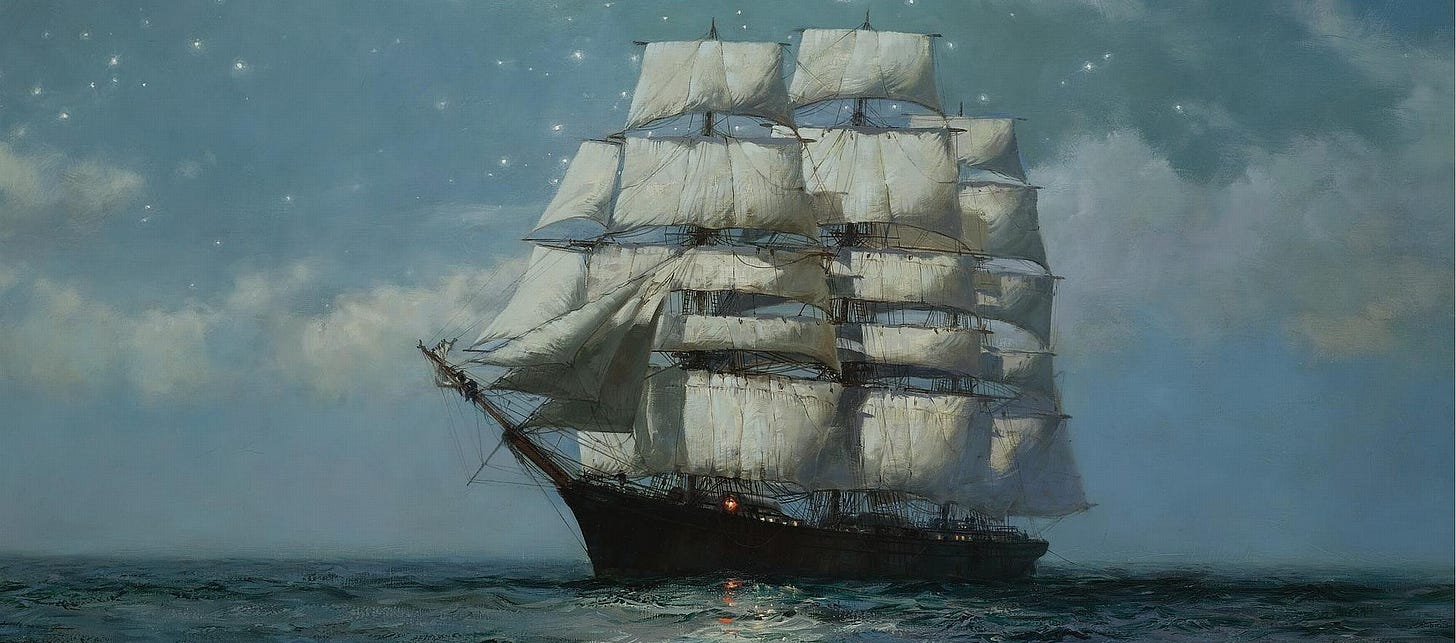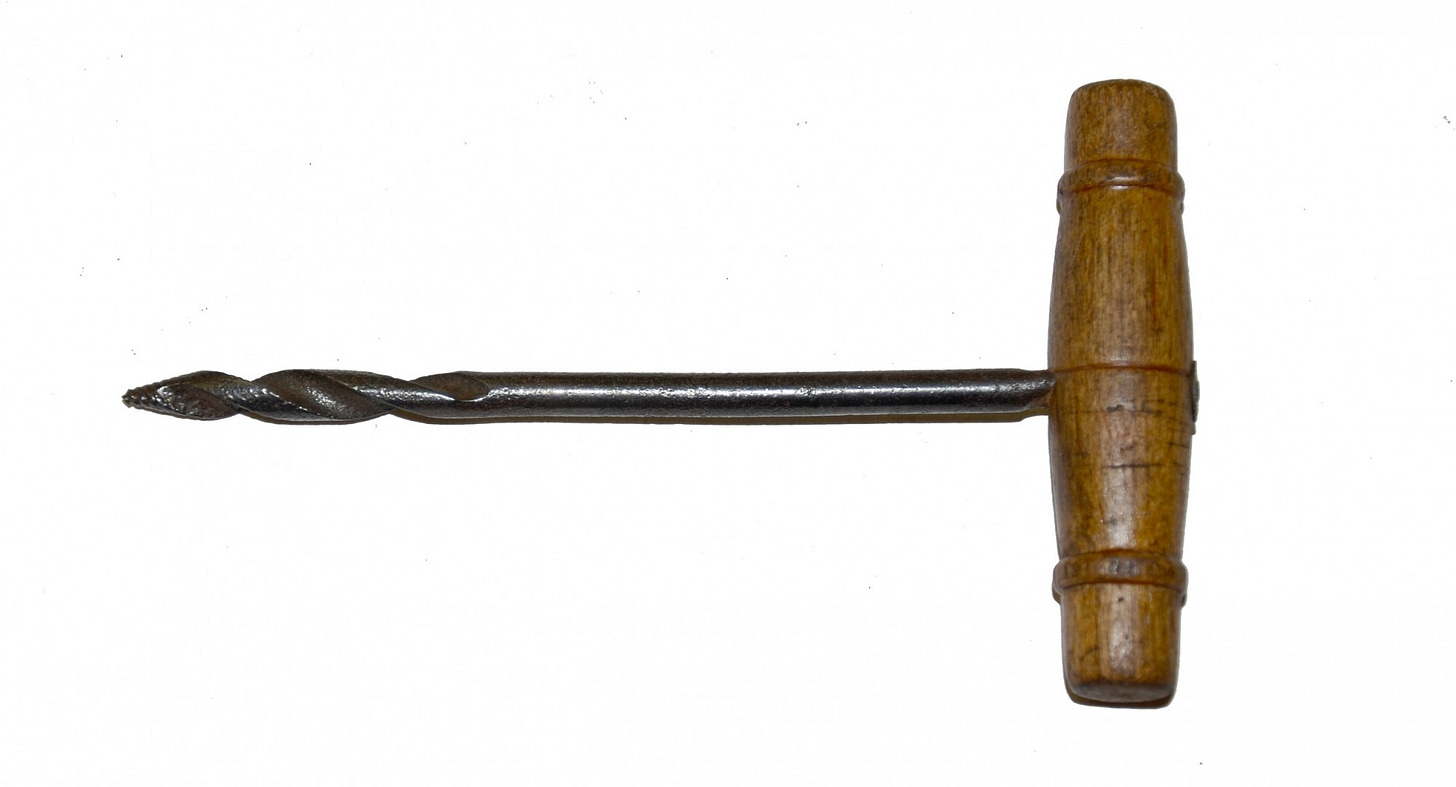The Gin Gimlet - Scurvy's scourge
The cocktail that made an empire.
Thomas burst into the door of the woodshop, carrying a toolbox, a strap over his shoulder. The box was heavy, but he was excited.
"I have it, Granddad."
The smell of fresh sawn wood, the sharp oily smell of tools. Thomas is always caught up with ideas when he comes here. This is a place where things are made, his grandfather creates birdhouses and stools and of course boats.
Sawdust floats in the air, as the sunlight filters through the dust-covered windows. Jars of nails, pegs, and fittings line the shelves, clinking softly when the floorboards creak underfoot. Sketches of tall-masted clipper ships are pinned haphazardly on the walls, the once-crisp paper now yellowed with age.
In the corner, hunched over a cluttered workbench, sits Albert, an elderly man whose weathered face bears the marks of a lifetime at sea. A retired master shipwright from the British Navy, Albert's hands remain steady and sure as he works on a model of a clipper ship.
Thomas hurried over and set the toolbox down with a thud. He opened the toolbox, his eyes searching for the tool his grandfather had asked him to retrieve.
Albert looked up, a smile warming his features as he saw his grandson's eager face. "Ah, Thomas! I see you've brought the old toolbox. Good lad. Now, let's see about putting that gimlet to work on this ship, shall we?"
Albert reaches for his trusted gimlet, the worn wooden handle fitting comfortably in his palm. The faint scent of metal and oil clings to the tool.
"You see, my boy," Albert begins, his voice gravelly. "This gimlet is a drill that lets us bore precise holes in timber without a single crack. It's essential for small work, like this model, but we used it on board the big ships too."
Thomas leans in, captivated, as he watches his grandfather's steady hand work the gimlet, carefully keeping the shaft perpendicular to the floor of the model.
"I got this gimlet from old John, my mentor. It brings back memories of my early days. I remember old John, teaching me, as a young apprentice, how to use it properly. 'Steady hands and a keen eye, lad,' he'd say. 'That's what separates the true craftsmen from the rest.' Those words have stuck with me all these years."
Albert hands the tool to Thomas. "Here, you take it. Hold the gimlet like a corkscrew. It drills into wood and takes the material out as well, making a sharp, small hole."
Thomas carefully positions the gimlet on the model, feeling the slight resistance as the tip meets the wood. With a steady hand, he applies pressure, the sound of the gimlet cutting through the oak filling the workshop. The scent of freshly drilled wood rises to his nostrils as he creates neat holes, following his grandfather's guidance.
Albert explains, "This ship is the Ariel, one of the legends. You're drilling the holes for the masts."
"But Granddad," Thomas asked, "didn't you say ships don't need sails anymore?"
A wistful smile plays on the old sailor's lips. "Aye, times are changing. When I was a young man, the ocean was a canvas painted with billowing white sails. Now, it's all steam and iron." He pauses, running a calloused thumb over the figurehead of the ship. "But mark my words, boy, there's a soul in these timber vessels no contraption can ever copy."
Thomas watches in awe as his grandfather seats the spars in the holes bored by the gimlet, the tall masts with rigging already attached rising from the deck.
"The Ariel had a long, sharp bow and she was made out of teak, and sheathed in copper, to keep her slippery in the water."
Albert weaves the familiar rigging into place, explaining each line to Thomas.
"She had three tall masts - the foremast, mainmast, and mizzenmast -- when the captain ordered all sails set, she was a sight to behold. Every inch of canvas straining to pull her through the water."
"We would be high up in these masts, working in the rigging high above the deck. Beautiful on a good day, terrifying on a bad one."
"You know, lad," Albert says, his hands stilling for a moment as his eyes grow distant, "life at sea wasn't always as romantic as the stories make it seem. In the early days, sailors faced the dreaded scurvy - a scourge that claimed countless lives. Men grew weak, their gums bled, and their teeth fell out. Thousands died."
Thomas's eyes widen in horror. "What caused it, Granddad?"
"Well, lad, at first we didn't know. But then the Navy realized it was because we weren't getting enough fresh fruits and vegetables. So, they started giving us lemon and lime juice to drink every day."
"Have you seen the bottle of Rose's Lime Cordial on the kitchen shelf? That was made for the Navy. The stuff we had was vile."
Thomas nods. "My mother insists I drink it daily. She says it's good for my health."
"Aye, lad, it is. The lime juice we had back in my day was much stronger, but it kept us sailors healthy on long voyages. To sail from India was over 100 days at sea."
Albert sighs heavily. "When the French finish the Canal in Suez there will be no need for voyages like that, ships will do it in under 50 days."
"The world's changing," he murmurs, eyes distant. "Sails yielding to steam."
As the model clipper takes shape beneath their fingers, it becomes more than just a woodworking project, it's a bond between grandfather and grandson.
Thomas looks his grandfather in the eye, determination dancing in his eyes. "I'll be a sailor too, Grandad," he declares earnestly. "I'll navigate by the stars and explore new places, just like you."
Albert smiles, tears welling in his eyes. Reaching into his pocket, he pulls out a small wooden case. "This was given to me by my father when I first set sail," he explains, voice thick with emotion. He opened the intricately carved box to reveal a small compass. "It's guided me through many a storm and always brought me back home. I made this box for it and now, I want you to have it. Keep it close to your heart and know that you are not alone."
Thomas leans into his grandfather's embrace, feeling his warmth and strength. "I'll make you proud, Grandad," he whispers, filled with determination. "I promise."
The name "Gimlet" has two supposed origins. One theory suggests the cocktail was named after the tool called a "gimlet," used for drilling small holes, alluding to the drink's "piercing" effect on the drinker. This tool was common on wooden sailing vessels.
Another theory suggests that it is named after Sir Thomas Gimlette, a surgeon in the Royal Navy, who advocated the use of lime juice to prevent scurvy. However, this is not mentioned or documented in his official biography and is thought to be fictional.
Scurvy is however key to the story of the Gimlet. Scurvy is a disease resulting from a deficiency in vitamin C, a nutrient necessary for the synthesis of collagen, a protein essential for the body's connective tissues. The symptoms include swollen and bleeding gums, joint pain, and fatigue. Before its cause was understood, scurvy was a significant problem for sailors during long sea voyages, where access to fresh fruits and vegetables was limited.
The disease has been recognized since ancient times, but it became a prominent issue for European sailors in the Age of Exploration, starting in the 15th century, when ships were at sea for extended periods without access to fresh produce.
Early treatments were based on trial and error, with various remedies attempted, including vinegar, elixirs, and the consumption of meat in various forms, but these were largely ineffective in preventing or curing scurvy.
The turning point in the battle against scurvy came in the mid-18th century with the work of James Lind, a Scottish naval surgeon. In 1747, while aboard HMS Salisbury, Lind conducted what is often considered one of the first controlled clinical trials in medical history. He divided twelve sailors afflicted with scurvy into six groups and administered different treatments to each group. The group that received oranges and lemons showed a remarkable improvement, leading Lind to conclude that citrus fruits could cure scurvy.
By the late 18th century, the British Admiralty began to take stronger measures against scurvy. Gilbert Blane, a physician to the fleet, played a crucial role in persuading the Navy to adopt health reforms. In 1795, the Navy started issuing lemon juice to sailors as a standard practice. This measure was remarkably successful, leading to a dramatic decline in the incidence of scurvy among British sailors. The successful management of scurvy in the English Navy was a strategic advantage that helped to create the British Empire. This lemon juice was preserved in about 15% alcohol.
For over 200 years, the Royal Navy issued a daily ration of alcohol, a tot, to every sailor. In 1850, the tot in the Royal Navy was changed from rum to gin, largely as it was cheaper, but also it was made in England and the quality was better monitored than Caribbean rum.
Around 1860, the Navy switched from lemon to lime juice, as limes were more readily available from British colonies in the Caribbean and easier to process. The practice of issuing lime juice helped control scurvy in the British Navy and contributed to the nickname "limey" for British sailors.
Lauchlin Rose, a Scotsman, patented his Lime Juice Cordial in 1867. He preserved limes without alcohol, and it became a staple on British ships. It wasn't long before the gin and lime juice were mixed, creating a basic form of what we now know as the Gimlet.
This became known first as a navy drink but by 1923 was noted in a drinks encyclopedia from New York. The classic recipe for a Gimlet calls for a simple mix of gin and Rose's Lime Juice. In Raymond Chandler's 1953 novel "The Long Goodbye," the protagonist, Philip Marlowe, notes that "a real gimlet is half gin and half Rose's Lime Juice and nothing else."
Ernest Hemingway drank gimlets on safari in Africa, with Rose's Lime Juice being perfect for the traveling writer. On TV's Mad Men, it's featured as Betty Draper's favorite drink.
Modern-day Gimlets have evolved from the original recipe. Many people's taste today is to reduce the amount of Rose's Lime Juice. The evolution of craft cocktails often involves toning down the Rose's in favor of fresh lime juice and simple syrup and sometimes increasing the gin to a three-to-one ratio.
The Chandler Gimlet
Ingredients:
- 1 ½ oz Gin
- 1 ½ oz Rose's Lime Juice
Instructions:
- Pour gin and lime juice into a mixing glass filled with ice.
- Stir well. Strain into a chilled cocktail glass. Can also be served on the rocks in a tumbler glass.
- Add a lime wedge as a garnish if you want to be civilized.
Notes:
Today two parts gin to one part Rose's Lime Juice is popular.
If you're ordering an old-school Gimlet, Rose’s will drown out any subtle aromatics, so save the fancy gin for Martinis.




Another good one Michael. I so look forward to your stories and save them to read when I have time to enjoy them. Genie